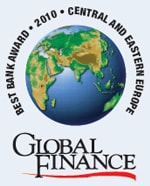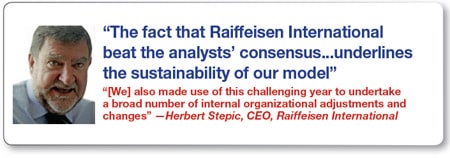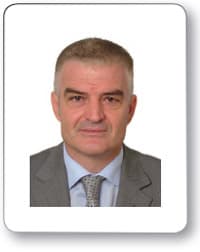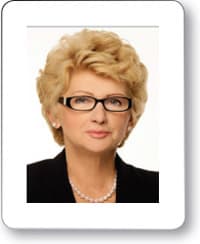EUROPE
By Paula L. Green
REGIONAL WINNER: RZB/Raiffeisen International
 Austria-based RZB/Raiffeisen International bags the regional award for the fourth year in a row after managing to turn in a creditable performance despite atrocious market conditions. With a 1.7% increase in GDP, Poland was the only country in central and eastern Europe to post economic growth in 2009. Most other economies contracted sharply, led by Ukraine’s 15% slump. The subsequent impact on companies and borrowers prodded Raiffeisen International to boost its loan loss provisions by 123%, to $2.35 billion, last year. Yet Raiffeisen International’s consolidated profits (after tax and minority interests) tallied nearly $296 million in 2009 while its balance sheet total was nearly $110 billion for the year.
Austria-based RZB/Raiffeisen International bags the regional award for the fourth year in a row after managing to turn in a creditable performance despite atrocious market conditions. With a 1.7% increase in GDP, Poland was the only country in central and eastern Europe to post economic growth in 2009. Most other economies contracted sharply, led by Ukraine’s 15% slump. The subsequent impact on companies and borrowers prodded Raiffeisen International to boost its loan loss provisions by 123%, to $2.35 billion, last year. Yet Raiffeisen International’s consolidated profits (after tax and minority interests) tallied nearly $296 million in 2009 while its balance sheet total was nearly $110 billion for the year.
“The fact that Raiffeisen International managed to clearly beat the analysts’ consensus by posting a net profit of €212 million for the exceptionally challenging year 2009 underlines the sustainability of our business model,” says Herbert Stepic, chief executive officer of Raiffeisen International and deputy chairman of RZB. “Raiffeisen International also made use of this challenging year to undertake a broad number of internal organizational adjustments and changes. We feel that we are very well positioned in an environment marked by improving economic indicators.”
Herbert Stepic, chief executive officer

Albania
International Commercial Bank
Part of the ICB Financial Group Holdings in Switzerland, International Commercial Bank of Albania posted double-digit growth in deposits and loans last year despite a financial crisis that created a difficult operating environment. This financial institution’s deposits jumped by 50% in 2009 while net loans increased by about 28% for the same year over 2008. ICB uses incentive schemes to motivate its employees, most of whom are local Albanians, which in turn helps create innovative products and strong customer service. Along with investments in technology and reductions in its turnaround time for the delivery of corporate loans and consumer mortgages, the bank expanded its loan portfolio and its customer base. It introduced simple savings accounts for retail customers and loan products for small and medium-size businesses, and opened two new branches outside the capital city of Tirana to reach the country’s agricultural heartland.
Mahendra Singh Rawat, chief executive officer
Belarus
Belarusbank
Despite the volatile economic climate that led to an economic contraction, intervention by the International Monetary Fund and a currency devaluation, Belarusbank increased its profits to $107.4 million last year, up from $84.1 million in 2008. Belarusbank is the country’s largest bank by assets, with more than $12 billion, up from about $11 billion in 2008. Along with other large banks in this former Soviet socialist republic, Belarusbank has the government’s backing. It again leveraged its dozen years of experience in the international financial markets, wide range of financial products and services and solid distribution channels to expand its corporate client base to nearly 88,000, up from 84,100 in 2008. Loans to customers increased to about $10.2 billion, up from $8.7 billion the previous year, and Belarusbank’s dedication to technology continued.
Nadezhda Ermakova, chairperson of the management board
Bosnia & Herzegovina
Raiffeisen Bank dd Bosna i Hercegovina
This commercial bank tackled the troubled banking environment in Bosnia and Herzegovina by enhancing its portfolio monitoring activities, strengthening support to retail and corporate customers and making credit risk management a top priority. As a result, this member of the Austrian Raiffeisen Bank family increased its corporate customer base by 9% in 2009 and kept the share of non-performing loans at 1.97%. The bank plays a prominent role in the local economy by serving more than 70% of the locally based large companies and provides a wide array of financial services, from cash management to global custody to corporate loans. The bank serves more than 3,000 corporate customers through eight regional corporate centers, and its online banking service for these customers, RBBHnet, had nearly 4,000 agreements in place at year end, up 65% over 2008. The Austrian parent, a majority shareholder, demonstrated its continued support by setting up a new head office building in Sarajevo.
Michael Mueller, chief executive officer
Bulgaria
UniCredit Bulbank
UniCredit Bulbank managed to preserve its position as the country’s largest bank and corporate banking leader despite an economic downturn that saw financial institutions across the country post double-digit drops in net income in 2009. Prudent regulation by the Bulgarian National Bank during the years of high growth has helped Bulgaria’s banking system maintain strong capital buffers. UniCredit Bulbank will also benefit from the risk management systems and procedures of its Italian parent, the UniCredit Group. The bank was created in 2007 with the merger of Bulbank, HVB Bank Biochim and Hebros Bank—all UniCredit Group entities. By emphasizing the efficient delivery of services and customer support during these turbulent times, the bank retained its leading market share of corporate loans and is a top player in retail banking. It offers customers a comprehensive banking network, with 230 branches and offices and 4,000 employees.
Levon Hampartzoumian, chief executive officer
Croatia
Privredna Banka Zagreb
 Bozo Prka, president and CEO |
Backed by Italian banking group Intesa Sanpaolo, which owns 76.6% of its share capital, Privredna Banka Zagreb (PBZ) is a modern universal bank serving corporate clients, including Croatian exporters. Always strong in Internet banking, PBZ launched the country’s first Internet trading platform for corporate and retail clients using the Croatian stock market and last year introduced a mobile telebanking service to complement its other widely used e-banking services. PBZ Bank posted net profit of $175 million in 2009 and held nearly $12.7 billion in assets. While net profits were down from $223 million the previous year, assets were up from the $12.4 billion recorded at year-end 2008. The bank is an integral part of the PBZ Group, which registered net profits of $182 million and $14 billion in assets in 2009 by offering banking, credit card, leasing, pension fund management and other financial services. |
Czech Republic
Ceskoslovenska Obchodni Banka

Pavel Kavanek, chairman of the board of directors and CEO |
This Czech bank posted an underlying net profit of $556.1 million in 2009, despite a decline of nearly 4% in the economy of this central European nation. Assets were up by 4% to $46.8 billion. One of the country’s top three banks, with about 20% of the Czech market for deposits and loans, CSOB is majority owned by Belgium’s KBC Group. That relationship will change somewhat this summer when KBC Group is expected to sell 30% to 40% of CSOB’s shares on the Prague Stock Exchange. Executives at CSOB declined to comment about the sale. KBC Bank had to seek government relief several times from the Belgian government during the global financial crisis. As a universal bank, CSOB’s customers include corporations, exporters and individuals. It is the last major Czech financial group to use the bancassurance concept—using its brand to sell all financial services products. |
Estonia
Swedbank
 Priit Perens, head of Swedbank in Estonia |
A key player in the financial markets of Estonia and the other Baltic nations of Lithuania and Latvia, Swedbank stepped in and helped the Estonian government with a $74 million loan last year. Though it enjoyed a reputation as a “tiger” in the European Union after its independence from the Soviet bloc nearly two decades ago, Estonia’s economy shrank by 14% last year. This contraction hit the results of Swedbank’s Estonian unit, and assets were $13.4 billion, down from $14.7 billion at year-end 2008. Previously operating under the Hansabank name, Swedbank serves domestic and multinational customers with financing, cash management, risk management services and lending products. As part of Sweden’s Swedbank, it offers companies an easy way to execute their corporate transactions within the Swedish bank’s network in the Baltic and Nordic countries. |
Hungary
OTP Bank
Part of the regional OTP Group that provides universal financial services in nine eastern European countries, OTP Bank is one of Hungary’s largest banks. It weathered the global financial crisis with a defensive strategy, as well as a loan from the state, that helped produce stability and profits even as Hungary’s economy shrank by more than 6% last year. By November 2009 the bank had paid back half of the $1.87 billion loan it had received from the Hungarian government seven months earlier. Carrying market conditions, the loan was intended to enable the bank to provide liquidity for Hungarian corporations. OTP Bank tallied assets of $52 billion at year-end 2009, up 4.1% from the $49.9 billion in assets in 2008. To help clients manage their temporary financial difficulties, the bank developed a loan protection program with specialized products. This Hungarian bank also introduced strict cost management controls and a state-of the-art credit and market risk management system to monitor the risks of a tough financial climate.
Sandor Csanyi, chief executive officer
Kosovo
Raiffeisen Bank Kosovo
Part of Raiffeisen International Bank-Holding since 2003, this Kosovo bank strives to build trust with all its business partners: individuals, small and medium-size enterprises as well as corporations. The bank’s ties with its Austrian parent mean it is a well-capitalized bank that actively lends to companies helping develop Kosovo’s economy. In 2009 RBK used improved services, smarter technology and additional products to strengthen its relationship with small businesses. Micro enterprises are crucial to the economic development of this former Yugoslav nation, and the bank’s Micro Enterprises segment now has micro-account officers in 26 branches and sub-branches. The bank also maintains a focus on the needs of entrepreneurs in the agricultural sector. Based in Pristina, the bank operates 50 business outlets around the country. In 2009 it established Raiffeisen Leasing, which offers leasing products, a new development in this country.
Robert Wright, chairman and CEO
Latvia
SEB
SEB Latvia is the second-largest commercial bank by assets in Latvia and fully owned by the SEB Group of Sweden. The bank last year operated in a turbulent Latvian economy devastated by an 18% drop in GDP, rising unemployment and declines in consumer prices and income. In the midst of the turmoil, SEB Latvia launched an internal domestic support program—without waiting for government-support mechanisms—that helped 5,000 households. It also used the downturn to strengthen its links with individual and business clients. The bank created a new personnel role—senior customer-service officer—to improve service to more than 65,000 small and medium-size companies. Financial analysts are reassured by the fact that the bank is supported by its parent, SEB Group, whose eastern European operations include a network of 229 branches throughout the Baltics.
Ainsars Ozols, chief executive officer
Lithuania
SEB
 |
SEB Lithuania used a conservative approach to customer risk and strict credit portfolio management to weather the 2009 economic crisis. As Lithuania’s largest bank, this financial institution has the backing of the SEB Group. This Swedish giant has more than 60 branches in Lithuania and improved service to multinationals doing business in the region with its Pan-Baltic Project. The service lets clients of the SEB Group receive the same services at all three SEB banks in Latvia, Estonia and Lithuania. SEB Lithuania’s new top managers—serious about taking responsibility for operating losses generated partly by the need to increase provisions for overdue loans—are optimistic that the banking sector will stabilize this year. “In 2009 the bank had a special focus on credit portfolio quality management, on optimization and increasing the bank’s operational efficiency; these will remain the bank’s key priorities in 2010 as well,” says Raimondas Kvedaras, president and chief executive officer of SEB Bank in Lithuania.
The bank also focused on its customers and spent $1.78 million in 2009 to upgrade its data-transmission network, which will speed up transactions at bank outlets and the exchange of information between branches. |
Macedonia
Komercijalna Banka AD Skopje
Komercijalna Banka AD Skopje is a private financial institution that has the largest bank network in Macedonia, with 60 branches. From its base in the capital city of Skopje, this universal bank offers a wide range of products and services to retail and corporate clients. It was the first brokerage house in Macedonia, one of the successor states of the former Yugoslavia, and represented more than 10% of the total trading volume at the Macedonian Stock Exchange by the end of 2009. Assets increased by 10.3% to $1.34 billion in 2009 while its market share stood at 22%. It was the first Macedonian credit card issuer and had captured 35.4% of this market by year-end 2009. Its corporate products include loans, foreign exchange, letters of credit and custody banking services.
Hari Kostov, chief executive officer
Malta
Bank of Valletta
 Tonio Depasquale, chief executive officer |
Created in the mid-1970s by the Maltese government to assume the business of the National Bank of Malta during a banking crisis, the Bank of Valletta is still known for operating a sturdy financial institution. Fitch Ratings earlier this year reiterated the long-term credit rating of Malta’s oldest bank—its history goes back two centuries—with an A- stable outlook, based on its strong capital and liquidity. At year-end 2009, the bank’s assets remained nearly the same as a year earlier, at $8.4 billion, and pre-tax profits were $110.6 million, double the pre-tax profits of 2008. Bank executives attribute the solid results to its deliberately conservative operating stance during the global financial crisis, during which the bank supported the community by making credit available to the corporate and personal sectors. Loans stood at nearly $4.5 billion at year end, up 6.8% from 2008, yet non-performing loans remained about the same at 3.9%. |
Moldova
Moldova Agroindbank
The largest commercial bank in this former Soviet republic wedged between Ukraine and Romania, Moldova Agroindbank managed to squeeze out nearly $12.8 million in net profits last year despite an economic crisis that pummeled the Moldovan economy. This universal bank started operations nearly two decades ago as a joint-stock company by taking over the assets and clients of Agroprom Bank. Today, it has a domestic network of 46 branches and assets of $656.4 million and has captured about 20% of the banking market in loans and deposits. It is recognized for its technology, the efficiency of its cash transfer operations and its adherence to top-of-the line information security management systems. It also is forging closer ties with international financial institutions, such as the European Bank for Reconstruction and Development, to attract foreign capital that can then be lent out to Moldovan businesses.
Natalia Vrabie, president
Poland
Bank Pekao
 |
Bank Pekao expects to keep riding the wave of Poland’s sustained economic growth. While Bank Pekao’s net profits were down to $845 million in 2009, the bank’s retail deposits increased by 4.7% and its corporate deposits by 8.4%. Assets were $45.8 billion. The technological integration of the nearly 300 branches absorbed through its 2008 merger with Bank BPH has been successfully wrapped up, and Bank Pekao is now the largest and most profitable private bank in this European Union nation. Majority-owned by Italy’s UniCredit, Bank Pekao has adhered to a conservative policy that relies on traditional banking with a strong deposit base and conservative risk approach. |
Romania
BRD-Groupe Société Générale
BRD-Groupe Société Générale strictly controlled its general expenses and tightened up risk control measures to battle a tough operating environment that saw demand for banking products and services drop as the Romanian economy sank by about 7% last year. The bank’s customer base remained diverse, with about 2.5 million retail customers, while more than 65% of its loans were made to private companies. This bank enjoys the institutional support of its French parent, Société Générale Group, a factor that prompted Fitch Ratings to upgrade its outlook for the bank’s long-term foreign currency rating to stable earlier this year. The Romanian bank also follows the strategy of its parent: a balanced business mix of retail, corporate and investment banking, long-term growth and efficient operations. Through BRD Corporate Finance, a subsidiary jointly held with its parent, the bank also can give companies top-of-the line advisory services in the privatization and merger and acquisition arena.
Guy Poupet, chairman and CEO
Russia
MDM Bank
Operating in a grim economy that contracted by approximately 9% in 2009, MDM Bank focused on controlling operating expenses and staff costs. Its integration with URSA Bank was completed successfully in August 2009. The two banks’ business lines and geographical presence complemented each other to forge a stronger, more diversified financial institution. MDM Bank held liquid assets of $3.5 billion at year-end 2009, up from $2 billion at the end of September. It is one of Russia’s largest privately owned financial institutions, with more than 27,000 corporate clients and nearly 3 million retail clients. It was the first private Russian bank to tap into the international debt market since the global financial crisis began in mid-2008, and its October 2009 signing of a $250 million syndicated loan was oversubscribed. The funds are to be used for trade-related financing and projects of bank customers.
Igor Kim, chief executive officer
Serbia
Raiffeisen Banka
This Serbian bank used the financial crisis as an opportunity to strengthen its risk management operations and ties with its corporate customer base. Part of the RZB Group of Austria, the bank introduced a system of early warning signals to better manage its credit risk and named a new head of risk management. As a way to diversify its loan and deposit portfolios while maximizing earnings, it separated the mid-size companies within its corporate banking sphere. The bank leads the Serbian market for both local firms and multinationals, which were the main driver of its income growth in 2009. Corporate customers can also tap into Raiffeisen Leasing and use the e-banking services of RaiffeisenOnLine International, which lets multinationals manage their payment operations in different countries from one place.
Oliver Roegl, chief executive officer
Slovakia
Tatra Banka
 Igor Vida, chairman and CEO |
Founded in 1990 as Slovakia’s first private bank, Tatra Banka is one of Raiffeisen Banking Group’s most successful subsidiaries in central and eastern Europe. Based in Bratislava, this universal bank serves corporate and retail clients through a network of nearly 150 business outlets, including 17 corporate centers. The bank focused heavily on maintaining existing deposits and attracting new funds as Slovakia completed its first year in the eurozone in 2009. With an economic contraction of 5% that dented the sales of small and medium-size companies, Tatra Banka strictly monitored its loan portfolio in this segment yet saw the portfolio increase by 11%. For its large corporate clients, the bank used strict risk management systems to maintain a healthy loan portfolio and introduced a new cash management product, Cash Management International. This lets companies manage their cash flows throughout the region with a single contact window at RZB in Vienna. |
Slovenia
Nova Ljubljanska Banka
Though it struggled in an economy that contracted by 6% in 2009 as unemployment reached 9%, Nova Ljubljanska Banka (NLB) still posted after-tax profits of $67.4 million and assets of $23.1 billion at the end of last year’s third quarter. Based on its assessment of the bank’s volume of capital and existing loan provisions, Moody’s says NLB should be capable of handling any additional deterioration in its credit portfolio. The largest bank in Slovenia, NLB is ready to tap into southeastern Europe’s expected long-term growth in financial services. It is backed by the NLB Group, an expansive financial services entity that includes 12 banks, 11 leasing companies, five insurers and a dozen international trade financing companies. Tucked between the Balkans and Austria, NLB uses its knowledge of east and west to offer corporate clients throughout southeastern Europe lending, export financing, investment banking, correspondent banking and other services.
Bozo Jasovic, CEO
Turkey
Akbank
This Turkish banking powerhouse defended its status as one of Turkey’s largest banks by maintaining a solid balance sheet and successful international links and by establishing stronger corporate governance practices. Bank managers dealt with the credit risks stemming from the global economic downturn by enhancing the bank’s risk management systems and containing the impact of bad loans. Akbank’s net profits jumped by nearly 53% to about $1.78 billion while assets were up 10% to about $68 billion. Its rate of non-performing loans was 3.8%. Akbank also opened up shop at the Dubai Finance Center in 2009, strengthening its international presence and setting the stage for it to capture a share of the Gulf region’s investment banking and corporate finance business. It also strengthened its corporate governance credentials in January when it aligned more closely with the 10 corporate social responsibility principles of the United Nations Global Compact by publishing its Communication on Progress Report.
Ziya Akkurt, chief executive officer
Ukraine
UkrSibbank
All Ukrainian banks felt the ill effects of an economy battered by low commodity prices and a severe 15% GDP contraction. Yet UkrSibbank retained the support of its main shareholder, BNP Paribas, which injected $166 million of new capital and expanded its stake in this Ukrainian bank to 81.42% in June 2009, up from the 51% share acquired four years ago. The bank then kicked off a large-scale restructuring process to bring it in line with its parent group’s practices, emphasizing stronger management methods and tougher, streamlined technology systems. The largest technology project implemented last year was the BNP Paribas Multichannel strategy, which lets clients carry out daily banking transactions through branches, call centers, the Internet and ATMs. A powerhouse in corporate banking, UkrSibbank retains relationships with more than 4,000 corporates, including industry leaders in metals, utilities and brewing. Its corporate current accounts and deposits tallied $324 million at year end.
Sergiy Naumov, chairman



